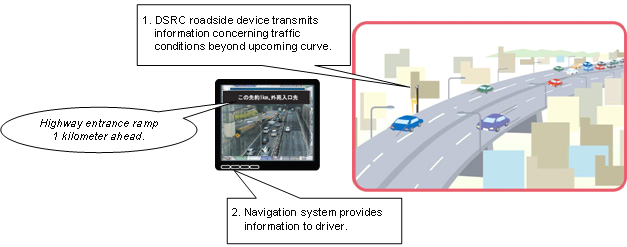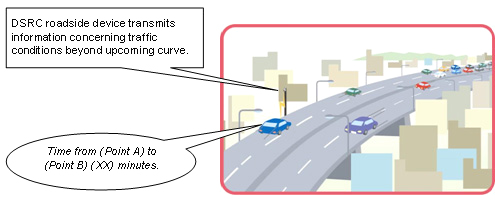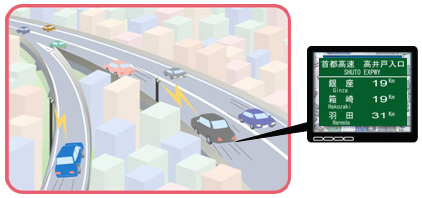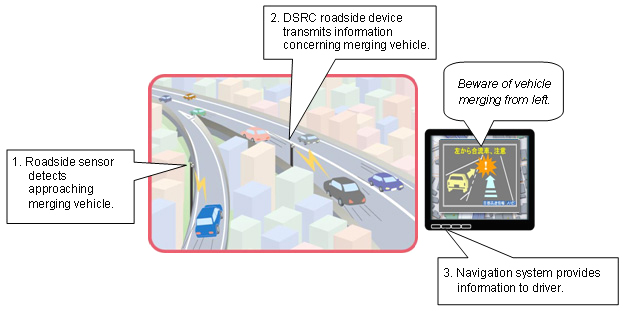Sep. 03, 2009
TMC Develops Onboard DSRC Unit to Improve Traffic Safety
―Vehicle-infrastructure Communications Aid Driver―
Tokyo ― TOYOTA MOTOR CORPORATION (TMC) announces it has developed, in coordination with an effort in Japan to develop next-generation roads, an onboard DSRC (dedicated short-range communications1) unit intended to increase traffic safety by providing drivers real-time, close-vicinity traffic information. TMC plans to offer the DSRC unit in Japan on a new vehicle model soon to be launched.
The navigation-system-linked DSRC unit, through the use of intelligent transportation systems (ITS) technologies, including Japan's electronic toll collection framework, receives a wide range of traffic information via vehicle-infrastructure communications and provides it to highway drivers in visual form and through voice guidance. It alerts drivers to obstacles they cannot see on the road ahead around curves, such as stopped vehicles and stopped-up traffic. It also alerts drivers to merging vehicles.
TMC's plan to offer the DSRC unit on a production vehicle represents the practical application of an ITS vehicle-infrastructure cooperative system that was developed through joint private-public sector research (from February 2005), verified in tests on the Tokyo Metropolitan Expressway (from May 2007) and demonstrated as part of the the ITS-Safety 2010 project2 conducted last fiscal year3.
Development of ITS vehicle-infrastructure cooperative systems that support safe driving, along with development and application of autonomous onboard safety devices, represents part of TMC's efforts to make driving safer. These efforts are based on TMC's "Integrated Safety Management Concept", which aims to provide optimal driving support through a combination of integrated onboard technologies and infrastructure-respondent systems.
Through such activities, TMC is reinforcing a wide range of traffic safety measures, including the development of safer vehicles and technologies, while also participating in the development of traffic environments and conducting traffic safety awareness activities, as part of its efforts to eliminate traffic fatalities and accidents toward the achievement of sustainable mobility.
The navigation-system-linked DSRC unit, through the use of intelligent transportation systems (ITS) technologies, including Japan's electronic toll collection framework, receives a wide range of traffic information via vehicle-infrastructure communications and provides it to highway drivers in visual form and through voice guidance. It alerts drivers to obstacles they cannot see on the road ahead around curves, such as stopped vehicles and stopped-up traffic. It also alerts drivers to merging vehicles.
TMC's plan to offer the DSRC unit on a production vehicle represents the practical application of an ITS vehicle-infrastructure cooperative system that was developed through joint private-public sector research (from February 2005), verified in tests on the Tokyo Metropolitan Expressway (from May 2007) and demonstrated as part of the the ITS-Safety 2010 project2 conducted last fiscal year3.
Development of ITS vehicle-infrastructure cooperative systems that support safe driving, along with development and application of autonomous onboard safety devices, represents part of TMC's efforts to make driving safer. These efforts are based on TMC's "Integrated Safety Management Concept", which aims to provide optimal driving support through a combination of integrated onboard technologies and infrastructure-respondent systems.
Through such activities, TMC is reinforcing a wide range of traffic safety measures, including the development of safer vehicles and technologies, while also participating in the development of traffic environments and conducting traffic safety awareness activities, as part of its efforts to eliminate traffic fatalities and accidents toward the achievement of sustainable mobility.
System setup
A roadside DSRC device sends traffic information and other information to help increase driving safety to the onboard DSRC unit; the unit then passes on the information to the driver through the navigation system in written, graphic or other image form or through voice guidance.
A roadside DSRC device sends traffic information and other information to help increase driving safety to the onboard DSRC unit; the unit then passes on the information to the driver through the navigation system in written, graphic or other image form or through voice guidance.

Main types of information provided
1) Information regarding obstacles ahead
Information concerning difficult-to-see obstacles such as stopped vehicles or traffic congestion beyond curves is provided through the navigation system, before the vehicle enters the curve.
1) Information regarding obstacles ahead
Information concerning difficult-to-see obstacles such as stopped vehicles or traffic congestion beyond curves is provided through the navigation system, before the vehicle enters the curve.

2) Information on merging vehicles
Information concerning the presence of merging vehicles is provided through the navigation system, when approaching areas in which merging vehicles are hard to see.
Information concerning the presence of merging vehicles is provided through the navigation system, when approaching areas in which merging vehicles are hard to see.

3) Information concerning conditions ahead
Information concerning traffic conditions is provided through the navigation system, at tunnels and other areas that are frequently congested.
Information concerning traffic conditions is provided through the navigation system, at tunnels and other areas that are frequently congested.

Information concerning traffic ahead is provided audibly according to current position and direction of travel.

4) Sign information
The DSRC unit provides information on present location, highway entrances and exits and simplified presentation of highway signs.
The DSRC unit provides information on present location, highway entrances and exits and simplified presentation of highway signs.

| 1 | 5.8GHz band short-range communication system |
| 2 | Public-private-sector project aimed at achieving by end of March 2011 practical application of vehicle-infrastructure cooperative systems, based on New IT Reform Strategy formulated by Japanese government's IT Strategic Headquarters in January 2006. |
| 3 | 5.8GHz band short-range communication system |










